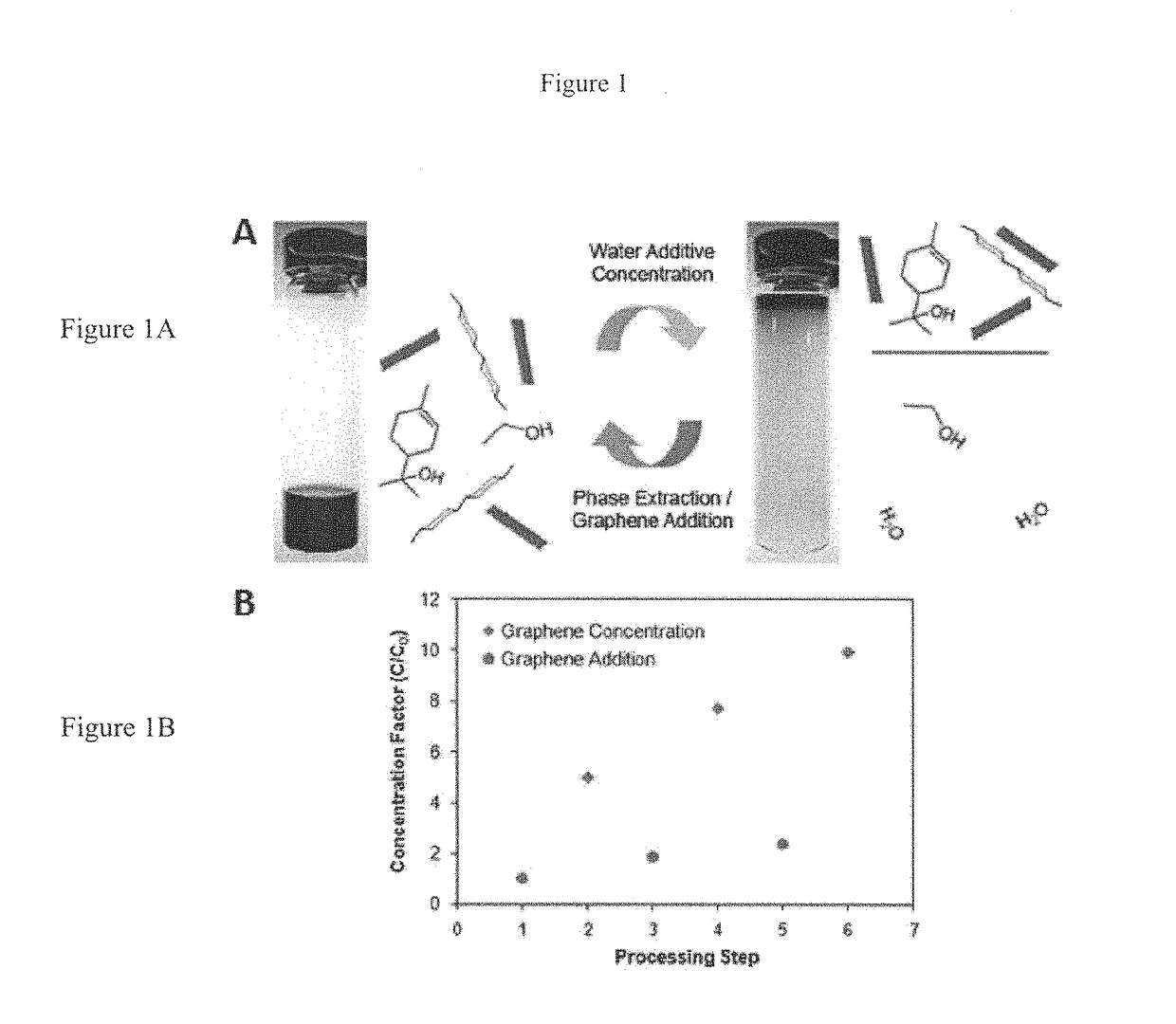Methods for preparation of concentrated graphene ink compositions and related composite materials
a graphene ink composition and composite material technology, applied in the direction of carbon-silicon compound conductors, printing, inks, etc., can solve the problems of reducing the electrical conductivity of go flakes, affecting the morphology of printing, and affecting the appearance of printing, so as to achieve the effect of substantially maintaining the morphology, electrical performance and mechanical properties
- Summary
- Abstract
- Description
- Claims
- Application Information
AI Technical Summary
Benefits of technology
Problems solved by technology
Method used
Image
Examples
example 1a
[0082]Exfoliation and Sedimentation Processing of Graphene.
[0083]2.5 g of natural graphite flake (3061 grade, Asbury Graphite Mills) was added to 50 mL of 1% w / v ethyl cellulose (EC) (Aldrich) ethanol (EtOH) solution inside a plastic 50 mL centrifuge tube (note that Aldrich does not explicitly provide the molecular weight of its EC; rather, the viscosity is specified (e.g., 4 cP) when the EC is loaded at 5% w / v in 80:20 toluene:ethanol). Two tubes containing this mixture were simultaneously sonicated in a Bransonic 3510 tabletop ultrasonic cleaner for 3 hr at 40 kHz and 100 W. In order to efficiently sediment out the graphite flakes, the centrifugation was performed in a two-step process. First, the sonicated graphene dispersions were centrifuged in a large volume centrifuge (Beckman Coulter Avanti J-26 XP Centrifuge) for 10 min at 7,500 rpm to remove the fast sedimenting graphite flakes. The supernatant was then decanted from each 50 mL centrifuge tube and combined. A second sedime...
example 1b
[0084]Thermal Stability of Polymer Enhanced Graphene Dispersions.
[0085]Experiments were undertaken to highlight the thermal stability of EC-based graphene dispersions, of the sort discussed above, especially in comparison to traditional surfactant-based dispersions. Here, graphene dispersions in 1% w / v EC-EtOH and 1% w / v sodium cholate-water (SC—H2O, prior art) were produced using the sonication and centrifugation procedures detailed above. Both dispersions were then concentrated to ˜1 mg / mL via thermal evaporation.
[0086]At elevated temperatures, graphene flakes in the SC-based dispersion agglomerate rapidly to form precipitates, while the EC-based dispersion remains well dispersed. To quantify their thermal stabilities, both concentrated dispersions were diluted to 0.1 mg / mL and centrifuged at 15,000 rpm for 1 min. The UV-vis absorbance spectra for their supernatants were then obtained. Using the same absorbance coefficient discussed above (2460 L / gm at 660 nm), it was determined t...
example 1c
[0087]Enhanced Graphene Production Efficiency in DMF.
[0088]Improvement in graphene production is also demonstrated by adding EC to dimethylformamide (DMF), which has moderate intrinsic graphene solubility. In this case, natural graphite was bath sonicated for 3 h at 50 mg / mL in both DMF and 1% w / v EC-DMF. After centrifugation at 7500 rpm for 4.5 h to remove the thick graphite flakes, UV-vis absorbance spectra were taken to assess their graphene concentrations (FIG. 1C).
[0089]Using an absorbance coefficient of 2460 L / g·m at 660 nm, the graphene concentration for the DMF and EC-DMF dispersions were determined to be 14.1 and 82.8 μg / mL, respectively. (See, Hernandez, Y.; Nicolosi, V.; Lotya, M.; Blighe, F. M.; Sun, Z.; De, S.; McGovern, I. T.; Holland, B.; Byrne, M.; Gun'Ko, Y. K.; Boland, J. J.; Niraj, P.; Duesberg, G.; Krishnamurthy, S.; Goodhue, R.; Hutchison, J.; Scardaci, V.; Ferrari, A. C.; Coleman, J. N., Nat. Nanotechnol. 2008, 3, 563-568). It follows that, the addition of 1% w...
PUM
| Property | Measurement | Unit |
|---|---|---|
| concentration | aaaaa | aaaaa |
| concentration | aaaaa | aaaaa |
| viscosity | aaaaa | aaaaa |
Abstract
Description
Claims
Application Information
 Login to View More
Login to View More - R&D
- Intellectual Property
- Life Sciences
- Materials
- Tech Scout
- Unparalleled Data Quality
- Higher Quality Content
- 60% Fewer Hallucinations
Browse by: Latest US Patents, China's latest patents, Technical Efficacy Thesaurus, Application Domain, Technology Topic, Popular Technical Reports.
© 2025 PatSnap. All rights reserved.Legal|Privacy policy|Modern Slavery Act Transparency Statement|Sitemap|About US| Contact US: help@patsnap.com



